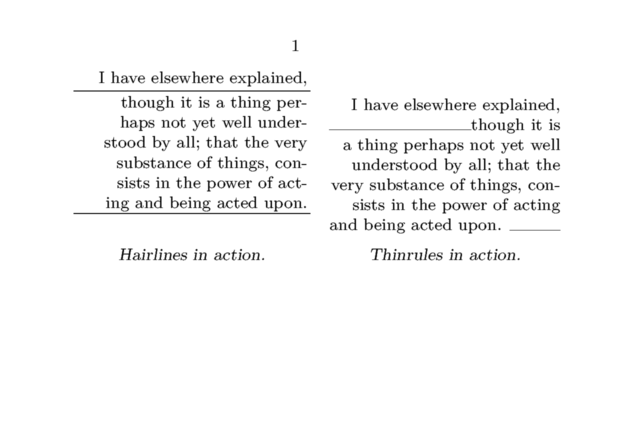Difference between revisions of "Command/thinrule"
< Command
Jump to navigation
Jump to search
| Line 24: | Line 24: | ||
\starttext | \starttext | ||
\startcombination[2*1] | \startcombination[2*1] | ||
| − | {\framed[width= | + | {\framed[width=4cm,align=left,frame=off]{% |
I have elsewhere explained, | I have elsewhere explained, | ||
\hairline | \hairline | ||
| Line 33: | Line 33: | ||
{Hairlines in action.} | {Hairlines in action.} | ||
% | % | ||
| − | {\framed[width= | + | {\framed[width=4cm,align=left,frame=off]{% |
I have elsewhere explained, | I have elsewhere explained, | ||
\thinrule | \thinrule | ||
| Line 50: | Line 50: | ||
\starttext | \starttext | ||
\startcombination[2*1] | \startcombination[2*1] | ||
| − | {\framed[width= | + | {\framed[width=4cm,align=left,frame=off]{% |
I have elsewhere explained, | I have elsewhere explained, | ||
\hairline | \hairline | ||
| Line 59: | Line 59: | ||
{Hairlines in action.} | {Hairlines in action.} | ||
% | % | ||
| − | {\framed[width= | + | {\framed[width=4cm,align=left,frame=off]{% |
I have elsewhere explained, | I have elsewhere explained, | ||
\thinrule | \thinrule | ||
| Line 73: | Line 73: | ||
\setupthinrules[color=green] | \setupthinrules[color=green] | ||
| − | {\framed[width= | + | {\framed[width=4cm,align=left,frame=off]{% |
I have elsewhere explained, | I have elsewhere explained, | ||
\thinrule | \thinrule | ||
Latest revision as of 09:11, 22 November 2021
Contents
\thinrule
Summary
The command \thinrule is used to draw a line.
Description
\thinrules are very similar to \hairlines in that
they provide means handle TeX's primitives \hrule and \vrule conveniently, or -- as the ConTeXt source puts it -- “free us from some specifications”.
The \thinrule command draws a rule on the current baseline, whereas an \hairline does exactly the same except that it creates a new paragraph for the rule alone. To the extent that the outcome of \hairline might depend on your paragraph settings and that they will always span the whole surrounding box horizontally, while \thinrules stay subordinate to the paragraph they occur inside.
The rule can be configured using \setupthinrules, but only horizontal options apply.
Examples
Example 1
The following example demonstrates the behaviour of \thinrule versus \hairline (MkII and MkIV).
\setupcombinations[style=\em] \starttext \startcombination[2*1] {\framed[width=4cm,align=left,frame=off]{% I have elsewhere explained, \hairline though it is a thing perhaps not yet well understood by all; that the very substance of things, consists in the power of acting and being acted upon. \hairline}} {Hairlines in action.} % {\framed[width=4cm,align=left,frame=off]{% I have elsewhere explained, \thinrule though it is a thing perhaps not yet well understood by all; that the very substance of things, consists in the power of acting and being acted upon. \thinrule}} {Thinrules in action.} \stopcombination \stoptext

Example 2
\setupthinrules[color=green] {\framed[width=4cm,align=left,frame=off]{% I have elsewhere explained, \thinrule though it is a thing perhaps not yet well understood by all; that the very substance of things, consists in the power of acting and being acted upon. \thinrule}}

Notes
See also
- pack-mrl.mkiv
- \hairline
- \fillinrules for rules for multiple-line answers.
- \fillinline for a 'write your answer here' rule at the end of the current line
- \setupthinrules for configuration
- \thinrules